Sad stories on the Earth

Environmental issues have increasingly become an essential topic not just in newspapers but also on TV too. Some experts believe that it is an urgent priority to use the power of TV for helping to heal the scars the Earth is bearing.
On the occasion of the Earth Day, April 22, a TV program gathered a group of environmentalist narrating stories about Iran’s vulnerable environment. Some of these stories must go around because this revolution in awareness has led to a much deeper understanding and appreciation of interrelationships or connections in nature as a major theme.
Davood Namayandeh, as a famous speaker pinpointed to degradation of crucial sources of biological wealth that are coming under increasing pressure from population growth and economic development.
“Saving the Earth rests on principles such as integrity and making adequate strategies for preserving that integrity but we all know that today our Mother Nature is sick and there is absolutely no balance on the Earth,” Namayandeh regretted.
Dr. Hossein Akhani, associate Professor from the Department of Botany of University of Tehran was one of the guests as well. He addressed the disastrous rates of plant extinction in Iran.
“An updated and much more through systematic synopsis of plant’s extinction reveals that more than 5,000 species have invaded foreign countries and are causing billions of dollars of damage every year,” Akhani said, adding, “But the rate of plant extinction is unclear because the study method is quite different; however, habitat destruction in Iran is the biggest factor threatening plant species with extinction.”
Dr. Iman Memarian, chief vet of Pardisan Rehabilitation Center, addressed some of extremist approaches such as hordes of feral dogs and cats in natural habitats of Iran. He mentioned it as a challenge for wildlife conservation saying “These problems have taken their toll on wildlife extinction and unfortunately nobody pays attention to them, even responsible institutions such as Department of the Environment (DoE) prefer to be neutral just because it has costs.”
Dr. Mehdi Zare, head of International Institute of earthquake engineering seismology explained that “knowledge brings a bounty of benefits to both our own health and planet; if we take a look to our works on the Earth, we understand even some of our seemingly good works have possibilities of posing threat against us and the environment, for instance, construction of Islamic Azad University, Science and Research Branch which is located on a fault and also it caused upheaval changes in Farahzad Region.”
Saman Golriz, an environmentalist and a celebrity chef also said that “we don’t even come close to being self-sustaining, we just exert significant adverse effects on the Earth.”
“Why Earth has no right? Why don’t we let it to heal? How much sea food we need? Why tones of foods are discarded around the world?” Golriz added.
Here are sad stories of how ignorant we are towards Erath
It’s early morning in Caspian Hyrcanian Forests. Suddenly loud roars that trail off into wheezing moans-territorial calls of jungle cat (Felis chaus) - wake up everyone. A female jungle cat trying to escape something went to the road where vehicles don’t usually pass. Her bitter fate resulted to another sad story of loss and death. Now this cat cubs are kept in the zoos. The Mother Nature just cries.
Rhinoceros horns are carved into ornate dagger handles that sell for $500-12,000 in Yemen and other parts of the Middle East. In china and other parts of Asia, powered rhino horns is used for medical purposes, particularly as a proven fever reducer, and occasionally as an alleged aphrodisiac. All five species of rhinoceros are threatened with extinction because of poachers (who kill them for their horns) and loss of habitat. From 1973 to 1990 the population of African black rhinos dropped from approximately 63,000 to about 2,400. The Mother Nature just cries.
Archeological surveys in Abu Dhabi have recovered various items such as shark vertebrae and teeth from sites that are over 7,000 years old. The demand for shark products, including meat and fins, is increasing in Asia and also in Persian Gulf region. Some of the species that are most in demand are the various species of hammerhead sharks and the sharks from the Carcharhinidae family that have ‘black fins’. It’s difficult to say which species are most vulnerable because we don’t have a regional assessment on the status of any of the species. Some of the most common species captured in the fisheries include the spot-tail shark, Carcharhinus sorrah, and the milk shark, Rhizoprionodon acutus. Reports from many countries in the Persian Gulf show that fish stocks are depleting and have reached worrisome levels. It is probable that many shark stocks are also facing declines due to overfishing and other threats. The Mother Nature just cries.
Unfortunately our Earth is not happy, she is terribly sick. We just use natural resources with absolutely no respect to the Mother Nature.
